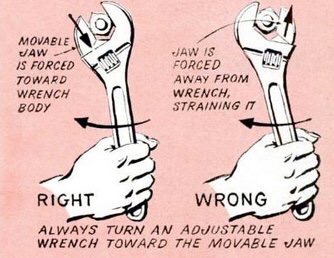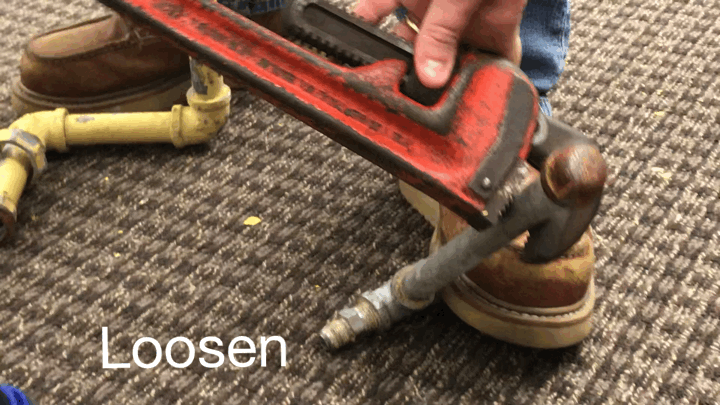Get Tech Tips
Subscribe to free tech tips.
How to Use an Adjustable (Crescent) Wrench, Pipe Wrench and Tongue & Groove (Channel Locks) Wrenches

My grandfather is a really interesting guy. He grew up working in the Pennsylvania coal mines starting at the age of 7 or 8. Then, he worked as a well driller, was a plumber, went to HVAC school, did some gas work, worked a while as an electrician, became a welder, was a diver, and ended up as an aircraft salvage man.
One of his favorite phrases is to call adjustable wrenches and channel locks (slip groove or tongue and groove pliers) “shoemakers' tools.“ I literally have no idea WHY he would call them that—or why he thought it was so funny to call them that—but he certainly didn't mean it as a compliment.
It is usually best to use a properly sized socket or wrench to do a job rather than reaching for a “multi-purpose” wrench. However, every tool has a purpose. If you are going to use a tool, it's best to use it properly. I know this is basic, but we can't assume everyone has a grandpa like mine. So, here is my guide about using adjustable wrenches and channel locks.

Pull, don't push (when you can)
Whenever possible, orient the wrench so that you are pulling rather than pushing. (Yes, I know I'm awkwardly pushing in the GIF below.) Pulling is a much more smooth and natural motion. As a result, you will be able to apply more force.

Pipe wrenches are special

Unlike adjustable wrenches, pipe wrenches are only for working with pipe, NOT nuts and bolts. I know that should be obvious, but I worked with a guy once who treated a pipe wrench like a regular wrench. Needless to say, he left a lot of damaged bolt heads in his wake.
A pipe wrench has sharp, angled teeth that will grip in one direction and release in the other direction. Open the jaw wide enough that the pipe sits in about the center of the pipe wrench, unlike a typical wrench that requires the object to be turned to sit all the way in the back of the jaws.
Keep in mind that a pipe wrench will leave marring on the surface of the pipe. If you don't want it to be damaged, you can use a leather (or even rubber) strap around the pipe to protect it before using the wrench. A leather belt can do the trick.


Turn the wrench toward the bottom jaw
Maybe there is an exception to the rule, but it's not in any of my wrenches. If you turn the wrench toward the bottom jaw, they will grip properly and be less likely to slip. In order to tighten vs. loosen, just flip the wrench over and turn in the opposite direction.
Righty-tighty is annoying
Half my childhood was HAUNTED by the phrase righty-tighty, lefty-loosey. IT IS ROUND! There is no right or left unless it is a reference to another direction (the top)! It's better said as clockwise-tighty… and yes, I know that doesn't sound cool. So, if you or an apprentice you know just HATES righty-tighty as much as I do, you're not alone. I explain how examples like “righty-tighty” are counterproductive in THIS article.
—Bryan
P.S. – If you'd like to learn more about tools, check out some of the tech tips and videos below:
Don't Forget the Service Wrench











Comments
Hello Bryan, I may know why your grandfather used to call adjustable wrenches and channel locks as “shoemakers tools”. I happened to visit the Channellock company website to learn more about channel lock pliers after reading your article and there I learned that in 1902 the company received an order for a “complete set of farrier’s tools from the royal horse-shoer for England’s reigning monarch Edward VII”. So I think that your grandfather called them “shoemakers tools” as they were probably very popular among horse-shoe makers at that time.
Hello Bryan, I may know why your grandfather used to call adjustable wrenches and channel locks as “shoemakers tools”. I happened to visit the Channellock company website to learn more about channel lock pliers after reading your article and there I learned that in 1902 the company received an order for a “complete set of farrier’s tools from the royal horse-shoer for England’s reigning monarch Edward VII”. So I think that your grandfather called them “shoemakers tools” as they were probably very popular among horse-shoe makers at that time.
One possible exception to the rule is the Bahco 9072 RP US Adjustable/Pipe Wrench when you reverse the jaws to use it as a pipe wrench. That is my emergency I forgot the pipe wrenches gas valve wrench.
One possible exception to the rule is the Bahco 9072 RP US Adjustable/Pipe Wrench when you reverse the jaws to use it as a pipe wrench. That is my emergency I forgot the pipe wrenches gas valve wrench.
To leave a comment, you need to log in.
Log In